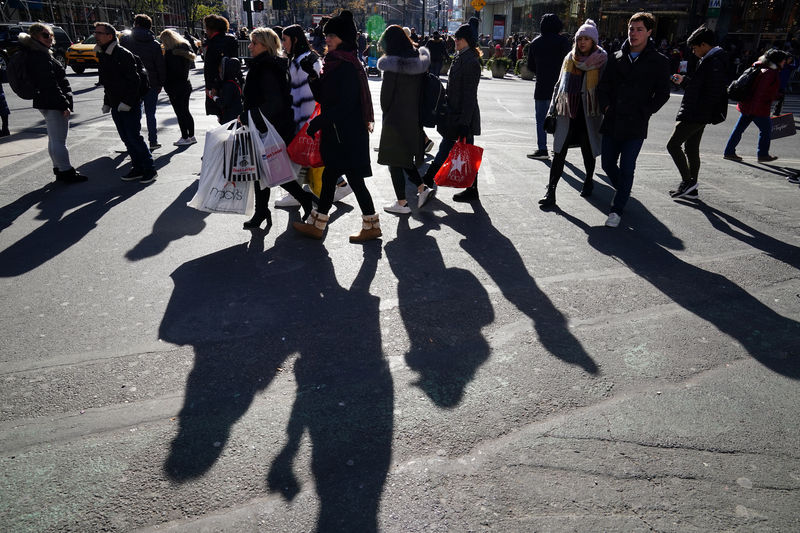 © Reuters. People walk in the sun during Black Friday shopping in New York City
© Reuters. People walk in the sun during Black Friday shopping in New York CityBy Manjul Paul and Indradip Ghosh
BENGALURU (Reuters) – There is a one-in-four chance of a U.S. recession in the next 12 months, a scenario that should keep the Federal Reserve from raising interest rates next month, according to a Reuters poll of economists who now expect only one rate hike this year.
Given a global economic slowdown and a dimming outlook for U.S. growth, economists said the Fed’s tightening cycle will likely draw to a halt before July.
While financial markets have recovered from a deep sell-off late last year, the Feb 8-14 poll of over 110 economists showed a cut to the outlook for U.S. economic growth and the number of Fed rate hikes this year and next.
“There is a lot of uncertainty and there are some good reasons to forecast a slowdown in 2019 as compared to in 2018,” said Jim O’Sullivan, chief U.S. economist at High Frequency Economics.
“It certainly does makes sense for the Fed to take a pause on policy to see how things play out, because it is not impossible for the economy to slow down in 2019 between weakening global growth, tighter financial conditions and fading fiscal stimulus.”
U.S. economic growth was forecast to slow and average 2.4 percent this year, a downgrade from January and the lowest since April last year.
On Wednesday, U.S. President Donald Trump said trade talks with China were “going along very well” as the world’s two biggest economies try to resolve their tariff war ahead of a March 1 deadline.
Reuters polls in recent months have repeatedly highlighted the U.S.-China trade war as the prominent downside risk for the American economy.
Over half the economists who answered an extra question warned any further escalation in the trade war would bring the next U.S. recession.
That compared to about 60 percent of economists in a July 2018 poll who said the trade war did not pose a significant risk.
(GRAPHIC: Reuters Poll – Impact of U.S.-China trade war – https://tmsnrt.rs/2EcK9th)
The median probability of a recession in the next year rose to 25 percent from 20 percent in January. It held at 40 percent over the next two years, although the most pessimistic call was 75 percent.
Expectations for Fed’s preferred inflation gauge were also slightly lowered from last month.
All but a couple of economists polled forecast the Fed to keep rates on hold at 2.25-2.50 percent when it meets March 19-20, echoing Chairman Jerome Powell’s dovish tone.
However, 51 of 101 economists said the Bank would take the fed funds rate to 2.50-2.75 percent next quarter, something over 75 percent of economists who answered an additional question said would not be a mistake.
“The Fed is very focused on slowing growth. If anything, the bigger risk is if the Fed goes too late rather than too early,” said Ethan Harris, head of global economics at Bank of America Merrill Lynch (NYSE:).
Only one hike is expected from the U.S. central bank this year, compared with 2 hikes suggested by the U.S. central bank’s own “dot plot” projections and in January’s poll. After next quarter’s hike the Fed is expected to stay on the sidelines through to the end of 2021 at least.
The outlook in Reuters polls for U.S. monetary policy tightening has been gradually cut since November, when the Fed was expected to raise rates three times in 2019.
Twelve economists now expect the Fed will not hike at all this year compared to just four respondents in the previous poll, which lines up with the views of U.S. short-term interest rate future traders.
“In light of some weaker economic data and comments from Fed Chair Powell, we did see the need to scale back our forecast on Fed tightening,” said Sal Guatieri, senior economist at BMO Capital Markets.
“Inflation pressures remain very subdued, a number of ‘so called’ cross-currents and headwinds are still important risks and until a lot of these issues are resolved, it is unlikely the Fed will raise interest rates. We see a lengthy delay right up to December and just one final rate increase this cycle.”
(Analysis by Mumal Rathore and Nagamani Lingappa; Polling by Sujith Pai and Tushar Goenka; Editing by Jonathan Cable and David Gregorio)
Source: Investing.com





























